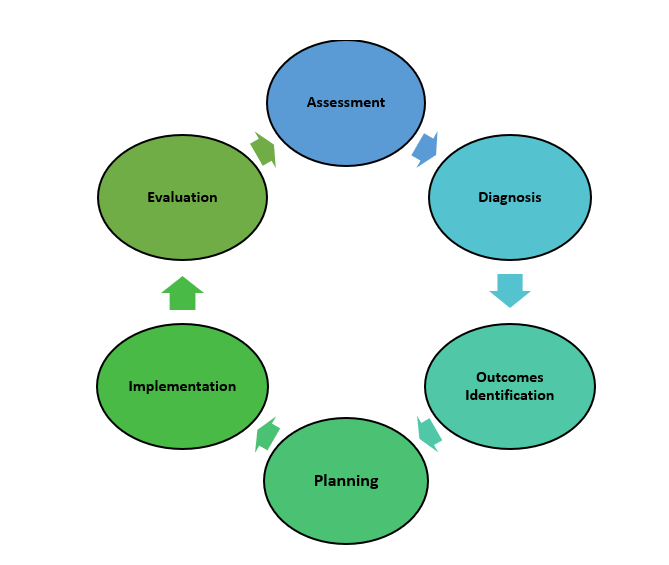3.2 Applying the Nursing Process
Open Resources for Nursing (Open RN)
The nursing process refers to a critical thinking model based on a systematic approach to patient-centered care. Since 2014, this systematic approach has been guided by the Psychiatric-Mental Health Nursing: Scope and Standards of Practice resource in alignment with the second edition of the ANA’s Nursing: Scope and Standard of Practice Nursing. The American Psychiatric Nurses Association (APNA) and the International Society of Psychiatric-Mental Health Nurses (ISPN) published the resource to guide psychiatric-mental health nurses in the application of their professional skills and responsibilities along with state Board of Nursing policies and practices that govern the practice of nursing.[1]
Nurses use clinical reasoning and make clinical judgments following the nursing process when providing patient care. The nursing process has been based on the Standards of Professional Nursing Practice established by the American Nurses Association (ANA). These standards are authoritative statements of the actions and behaviors that all registered nurses, regardless of role, population, specialty, and setting, are expected to perform competently.[2] The mnemonic ADOPIE is an easy way to remember the six ANA standards regarding the nursing process. Each letter refers to one of the six components of the nursing process. See Figure 3.2a[3] for an illustration of the nursing process.

New Framework for the Nursing Process
The National Council of State Boards of Nursing (NCSBN), in preparation for revisions of the NCLEX licensure exam that was implemented in 2023, developed an evidence-based framework that supported the new NCLEX question format and provided emphasis on clinical judgment and decision-making processes. The NCSBN Clinical Judgment Model complements the nursing process but uses different terminology in both providing care and in exam questions. This terminology includes: recognize cues, analyze cues, prioritize hypotheses, generate solutions, take actions, and evaluate outcomes. It is important to understand not only new terminology, but the need for focusing on relevant, important, and immediate information when caring for patients.
See Table 3.1 for a comparison of these terms and actions to the traditional nursing process.[4],[5].
The ADOPIE Nursing Process and the NCSBN Clinical Judgement Model complement one another and can be used together.
Table 3.1 Comparison of the NCSBN Clinical Judgment Measurement Model to the ADOPIE Nursing Process
| NCSBN Clinical Judgment Skill | Description | Corresponding Step of the Nursing Process |
|---|---|---|
| Recognize Cues | What data is clinically significant?
Determining what patient findings are significant, most important, and of immediate concern to the nurse (i.e., identifying “relevant cues”). |
Assessment |
| Analyze Cues | What does the data mean?
Analyzing data to determine if it is “expected” or “unexpected” or “normal” or “abnormal” for this patient at this time according to their age, development, and clinical status. Identifying where care is needed. Making a clinical judgment concerning the patients’ “human response to health conditions/life processes, or a vulnerability for that response,” also referred to as “forming a hypothesis.” The term hypothesis is dissimilar from usage in the scientific process. Here it implies identification of what the data mean. |
Diagnosis
(Analysis of Data) |
| Prioritize Hypotheses | What hypotheses should receive priority attention?
Ranking patient conditions and problems according to urgency, complexity, and time. |
Planning |
| Generate Solutions | What should be done?
Planning individualized interventions/actions that meet the desired outcomes for the patient; may include gathering additional assessment data. |
Planning |
| Take Action | What will I do now?
Implementing interventions/actions that are safe and most appropriate for the patient’s current priority conditions and problems. |
Implementation |
| Evaluate Outcomes | Did the interventions/actions work?
Comparing actual client outcomes with desired patient outcomes to determine effectiveness of care and making appropriate revisions to the nursing care plan. |
Evaluation
|
The following sections will explore each part of the nursing process in depth and incorporate the two frameworks and terminology.
- American Nurses Association, American Psychiatric Nurses Association, and International Society of Psychiatric-Mental Health Nurses. (2014). Psychiatric-Mental Health Nursing: Scope and Standards of Practice (2nd ed.). Nursebooks.org ↵
- American Nurses Association. (2021). Nursing: Scope and standards of practice (4th ed.). American Nurses Association. ↵
- “The Nursing Process” by Kim Ernstmeyer at Chippewa Valley Technical College is licensed under CC BY 4.0 ↵
- Ignativicius, V. & Silvestri, L. (2022). Preparing for the Next-Generation NCLEX (NGN): A “how-to” step-by-step faculty resource manual. Elsevier. https://evolve.elsevier.com/education/wp-content/uploads/sites/2/NGN_FacultyGuide_Final.pdf ↵
- National Council of State Boards of Nursing (2025). NCLEX: About the NCLEX. www.nclex.com/clinical-judgment-measurement-model.page ↵
A critical thinking model based on a systematic approach to patient-centered care.
A mnemonic for the components of the nursing process: Assessment, Diagnosis, Outcomes Identification, Planning, Implementation, and Evaluation.

